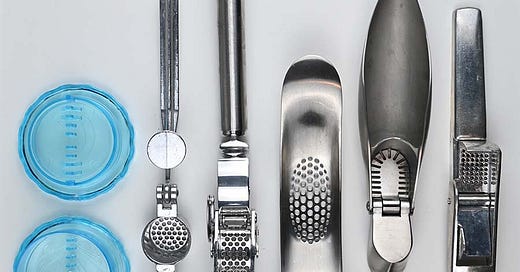The recipe calls for crushed garlic. You have several garlic presses, but which one should you use? Maybe you like the one with the easiest clean up? Or the one that can handle the smaller cloves? Or the one that’s easiest to manage with arthritic hands? There’s no wrong or right answer, just pros and cons for each choice.
There are so many patterns floating around. New patterns are being released all the time. Walk into any thrift store and find patterns. There are clubs with monthly releases, frequent sales at big box craft stores, not to mention free patterns like those offered by Peppermint Magazine or the V&A.
Given this bounty, how do you choose? What constitutes a “good” pattern? Often people will declare a pattern to be “good” if it fits out of the envelope. Which yes, is definitely good for that individual, but might not apply more generally. Most people require adjustments for fit. Plus it is very likely that the garment making community has a greater proportion of people with marginalized bodies than the general population.
When someone is learning TDCO, I highly recommend starting with a basic quality commercial multi-sized pattern.
has a list on Threadloop of suggested patterns for learning Top Down Center Out.Just as cooking with quality tools is more satisfying, sewing with quality patterns provides an effective foundation for learning. Yes, you can use TDCO for all patterns and all bodies and even for self-drafted pants. It is worthwhile to take the time and set yourself up for success in learning this new approach.
Which brings us right back to our question of selecting a quality pattern.
I wrote an article on this topic that is now published in Threads magazine Winter 2024 Issue #227.
Read on for more about this article including, IMO, a key point that did not make it into the published article.
Considerations for choosing a pattern
The minimum a pattern should provide is a clear communication of the design and fulfill the expectation that a finished garment constructed from the pattern will be an accurate replica of the design.




